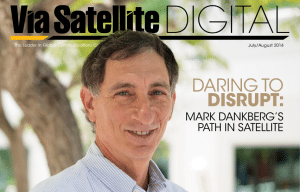Latest News
Highlights of Via Satellite: July’s Top 10 Quotes
[Via Satellite 07-23-2014] As the satellite industry continues to grow and evolve, the winds of change can be felt in nearly every sector. The July issue of Via Satellite touches on some of the prominent areas of change as new technological advances begin reshaping the landscape.
We talk to leaders from the world’s main launch companies about the business of rocket science, as well as top satellite manufacturing executives about pursuing disruptive technologies in a conservative industry. We also take a close look at the entrepreneurial success story of Mark Dankberg from the critical steps that inspired him to cofound ViaSat to challenges he never imagined.
To sample our latest issue, here are the top 10 quotes from Via Satellite’s July issue:
“There seems to be a situation at the moment where people are much more keen to fund projects that are perhaps pushing the envelope as far as the technical issues are concerned. I think we’re in a cycle now where people are saying, ‘let’s push the boat out and take a chance.’” – Jeremy Rose, principal, Comsys
“We are dealing with top technologies. As soon as you touch space, you are really at the edge of what mankind is able to produce.” – Eric Béranger, head of Airbus’s satellite manufacturing division
“One of the things I like is for us not to get too comfortable with the business model. I would rather disrupt industries than be the disrupted.” – Mark Dankberg, chairman, CEO and cofounder, ViaSat
“Most of our customers today have an incredible amount of technical expertise … we’re not shy, and we ask them what their opinion is. That way, at the end of the qualification process, when we are ready to deploy new technology and new products, it’s a lot easier. It’s a long process, and it has to be done in little steps.” – John Celli, president, Space Systems/Loral (SSL)
“In the past the government told us, ‘we want that redundancy; we want you to maintain it.’ Now they’re saying ‘be competitive, be lower cost,’” – George Sowers, VP of strategic architecture, United Launch Alliance
“A couple of years ago, as it became obvious that we were transitioning from large development efforts to more production satellites in our government market, and likewise the prospects that the government markets were likely to be flat and perhaps even declining, we really shifted our attention to reestablish a strong position in the commercial and international market,” – Mike Hamel, president of commercial ventures, Lockheed Martin Space Systems
“When we started, it was a total bootstrap company. So, [we did] everything from buying parts, to soldering circuit boards, writing manuals, and writing technical proposals, etc. Doing everything together to grow the company in these early days really helped knit together a very close team.” – Mark Dankberg, chairman, CEO and cofounder, ViaSat
“Electric propulsion is now seen as one additional tool for the manufacturers to propose … the most efficient solution, but it’s not expected to become dominant,” – Stéphane Gounari, senior analyst, Northern Sky Research
“No company out there competing in the commercial launch market is truly a commercial company except probably SpaceX,” – Marco Caceres, senior analyst, Teal Group
“The complexity today still demands additional costs for integration and testing … but that will come down eventually. There will still be a difference between the real flexible satellites and the non-flexible [spacecraft], but the difference will be shrinking.” – John Celli, president, Space Systems/Loral (SSL)
Get the latest Via Satellite news!
Subscribe Now